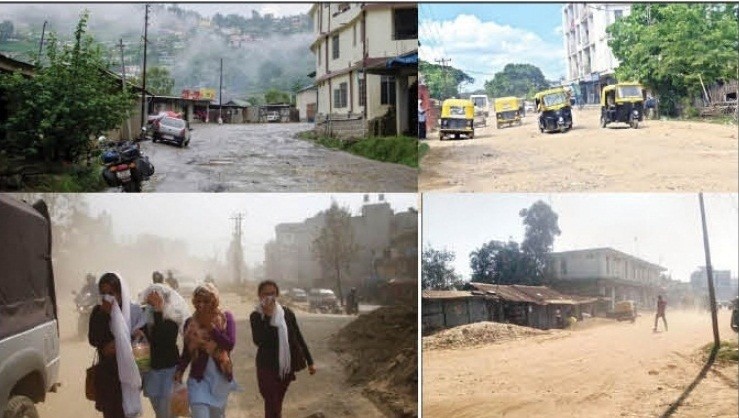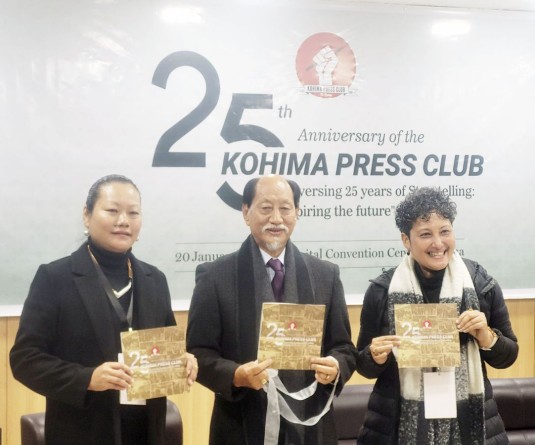A collage of photos taken in Dimapur and Kohima depicts the condition of roads in both places. According to Nagaland Pollution Control Board (NPCB), bad roads are major contributing factor for both being listed as polluted cities and violating the prescribed National Ambient Air Quality Standards (NAAQS) by the Central Pollution Control Board. (Photo Courtesy: NPCB).

Moa Jamir
imapur | September 4
The quality of air in Dimapur and Kohima does not meet the national air quality standards, and is rapidly deteriorating. They are listed as polluted cities and violating the prescribed National Ambient Air Quality Standards (NAAQS), according to the Central Pollution Control Board (CPCB).
Since 2011, at least 94 Indian cities—including eight towns and cities of the Northeast region—have consistently recorded higher than acceptable particulate matter (PM10) levels.
Consequently, the CPCB has recently directed three NE states – Assam, Meghalaya and Nagaland – to make an “action plan” to control air pollution by laying emphasis on both micro level and regional strategies.
The CPCB over the years is executing nation-wide programme of ambient air quality monitoring known as National Air Quality Monitoring Programme (NAQMP), with a network of operating stations in all states and Union Territories of the country. Among others, it has undertaken determining the status and trends of ambient air quality; to ascertain whether the prescribed ambient air quality standards are violated; to identify non-attainment cities; and to obtain the knowledge and understanding necessary for developing preventive and corrective measures.
[caption id="attachment_299674" align="aligncenter" width="960"] NPCB data depicting the monthly average concentration of RSPM for Bank Colony & Dhobinala Stations, Dimapur.[/caption] [caption id="attachment_299673" align="aligncenter" width="893"] NPCB data showing the Annual Average Concentration of RSPM in Dimapur during 2011 to 2016.[/caption] [caption id="attachment_299672" align="aligncenter" width="951"] NPCB data showing the Annual Average Concentration of RSPM in Kohima,
during 2011 to 2016.[/caption] [caption id="attachment_299671" align="aligncenter" width="480"]
The air quality samplers keep by the NPCB at its four monitoring stations in Dimapur and Kohima. The sample sheets were initially white but become black with the accumulation of various air pollutants. (NPCB photos)[/caption] Four air pollutants - Sulphur Dioxide (SO2), Oxides of Nitrogen (NO2), Respirable Suspended Particulate Matter (RSPM/PM10) and Fine Particulate Matter (PM2.5) have been identified for regular monitoring at all the locations. In Nagaland, there are four such stations, two in Kohima and two in Dimapur, one commercial and residential area each in the respective districts.
The Stations are monitored by the Nagaland Pollution Control Board (NPCB), a statutory body that was constituted in February 1991 under the provision of Section 4 of the Water (Prevention & Control of Pollution) Act, 1974, with mandate to protect the environment, and prevent and control pollution in the state.
Using Respirable Dust Samplers, the NPCB monitors RSPM, NO2, and SO2 at Bank Colony and Dobhinalla in Dimapur and Opposite NST office and Opposite War Cemetery in Kohima.
“The monitoring of pollutants is carried out for 24 hours; 8 hourly sampling for particulate matter (RSPM) and 4 hourly sampling for gaseous pollutants (NO2 & SO2) twice in a week,” informed Meren Imchen, Scientist B at NPCB. As of now, the Board does not have the analyzer to measure PM2.5 which is most risky for humans.
Main culprit
The main culprit is bad and dusty roads, Rusovil John, NPCB Member Secretary, told The Morung Express. His diagnoses are not misplaced. The NPCB monitoring data show that in all the four monitoring stations, the RSPM level shot-up drastically during dry seasons.
For instance, while the level PM10 level were below 100 from April-October, the Bank Colony monitoring station data show that it shot-up from 89 in October to 145 in November. In January it was 199. At Dobhinalla station, during the same period, it increased from 105 to 167, reaching 207 in January.
The annual average concentration in Kohima increased from 77 in 2011 to 92 in 2016 while it increased from 89 to 125 in Dimapur.
Other suspected culprits include vehicular emissions, brick kiln & wood based industries, burning of waste and lack of proper drainage system.
Burning of waste is a big concern, Imchen noted, as it often includes toxic waste like plastic, a major health hazard. Lack of robust transport system with the proliferation of vehicles adds to noise as well as air pollution, he added.
Health risks
The condition of air quality is a big concern as other studies have shown similar result. For instance, the World Health Organisation (WHO) ‘Global Urban Ambient Air Pollution Database’ updates released on May 2016 showed that pollution level in both places is increasing.
Kohima is one of the cities where pollution level has drastically worsened since the last report in 2014, the WHO report indicated. In 2104 database, Kohima’s PM10 level was at 64 but it rose to 82 in 2016. Most alarmingly, the PM2.5 particles, which carries the most health risk has nearly doubled in the intervening period – increasing from 28 (2014) to 44 (2016).
The PM2.5 level in Dimapur increased from 40 to 48 during the intervening period. As per WHO’s Air quality guidelines, the threshold and limit value for particulate matter are 20 μg/m3 for PM10, and 10 μg/m3 for PM2.5.
As urban air quality declines, the risk of stroke, heart disease, lung cancer, and chronic and acute respiratory diseases, including asthma, increases for the people who live in them, the report noted.
Steps being taken
The role of the NPCB is limited to advisory, as it is not an implementing agency.
As to whether the board can control vehicular emissions or other pollutants, Rusovil John said, “The NPCB role is advisory not an implementing agency. We can only issue emission standard and it is the duty of the transport department to implement the same.”
Same is the case for other departments.
However, awareness campaigns are making changes at ground level. Due to such activities, many stone crushers in residential areas have been relocated elsewhere, he informed.
Further, all the brick kilns in Dimapur are now built permanently with the mandated 30 metres height, Meren Imchen added. Waste burning has also been drastically down but waste and sewage treatment are required, the NPCB Scientist B opined.
In Kohima, in association with the KMC, push-cars were introduced with volunteers going door-to-door for recycling. In some localities, people have started segregating re-cycle and non-recyclable material, Rusovil John added.
For starting industries and other enterprises, the NPCB issues environmental standards and concerned entity has to get a sort of ‘No Objection Certificate’ from the Board. They are issued with various conditions.
The NPCB is also aware of the directive from its central board and said that it is currently in the process of formulating an action plan. It will come out with the action plan within a month, the Member Secretary informed.
However, the onus lies with the government and the implementing agencies to carry the plan forward.





